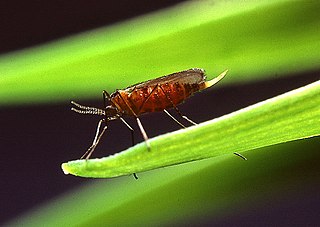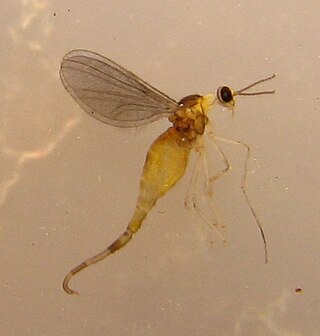
Cecidomyiidae is a family of flies known as gall midges or gall gnats. As the name implies, the larvae of most gall midges feed within plant tissue, creating abnormal plant growths called galls. Cecidomyiidae are very fragile small insects usually only 2–3 mm (0.079–0.118 in) in length; many are less than 1 mm (0.039 in) long. They are characterised by hairy wings, unusual in the order Diptera, and have long antennae. Some Cecidomyiids are also known for the strange phenomenon of paedogenesis in which the larval stage reproduces without maturing first. In some species, the daughter larvae consume the mother, while in others, reproduction occurs later on in the egg or pupa.

The Cecidomyiinae, commonly known as gall midges or gall gnats, is the largest subfamily in Cecidomyiidae with over 600 genera and more than 5000 described species. This subfamily is best known for its members that induce galls on plants, but there are also many species that are fungivores, parasitoids, or predators as maggots.

Mayetiola are a genus of flies from the family Cecidomyiidae. Most species are pests of cereal crops.

Rabdophaga is genus of flies in the family of gall midges Cecidomyiidae. There are 105 species distributed through Africa, Asia, Europe and North America. Most species of Rabdophaga gall willows ; one exception is R. giraudiana which galls the stems of poplars.

Schizomyia is a genus of gall midges. It has a cosmopolitan distribution.

Cecidomyiini is a tribe of gall midges in the family Cecidomyiidae. There are at least 220 described species in Cecidomyiini.

Asphondylia is a cosmopolitan genus of gall midges in the family Cecidomyiidae. All species in this genus induce galls on plants, especially on flowers and flower buds. There are over 300 described species in Asphondylia, with many more likely to be discovered and described, especially in the southern hemisphere.
Alycaulini is a tribe of gall midges, insects in the family Cecidomyiidae. There are about 20 genera and at least 200 described species in Alycaulini.
Parallelodiplosis is a genus of gall midges, insects in the family Cecidomyiidae. There are at least 20 described species in Parallelodiplosis.
Resseliella is a genus of gall midges in the family Cecidomyiidae. There are at least 50 described species in Resseliella.
Micromyinae is a subfamily of wood midges, insects in the family Cecidomyiidae. Its members were formerly included in subfamily Lestremiinae. There are at least 55 genera and more than 650 described species in Micromyinae. All species in this subfamily are mycophageous.

Winnertziinae is a subfamily of gall midges and wood midges in the family Cecidomyiidae.

Janetiella is a genus of gall midges in the family Cecidomyiidae. There are at least thirty described species.
Dicrodiplosis is a genus of gall midges in the family Cecidomyiidae. There are about 15 described species in Dicrodiplosis.

Winnertzia is a genus of gall midges and wood midges in the family Cecidomyiidae. There are more than 90 described species in Winnertzia.
Porricondylinae is a subfamily of gall midges and wood midges in the family Cecidomyiidae.









